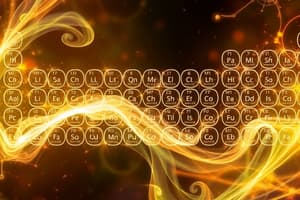Podcast
Questions and Answers
What do the columns of the periodic table pertain to?
What do the columns of the periodic table pertain to?
- Periods of elements
- Families of elements
- Blocks of elements
- Groups of elements (correct)
What is an isotope?
What is an isotope?
- A molecule that has more than two atoms
- An atom that has gained or lost electrons
- An atom with the same atomic number but different atomic mass (correct)
- An atom with a different atomic number
What is the term for the attraction between two atoms that have a partial positive charge and a partial negative charge?
What is the term for the attraction between two atoms that have a partial positive charge and a partial negative charge?
- Covalent bond
- Polar covalent bond (correct)
- Electrostatic bond
- Ionic bond
What is the term for an atom that has lost or gained electrons?
What is the term for an atom that has lost or gained electrons?
What is the term for the electrons in the outermost energy level of an atom?
What is the term for the electrons in the outermost energy level of an atom?
If an atom has 5 valence electrons, what is its valence?
If an atom has 5 valence electrons, what is its valence?
What is the term for an atom that has gained or lost electrons?
What is the term for an atom that has gained or lost electrons?
Which of the following subatomic particles weighs 1 Dalton?
Which of the following subatomic particles weighs 1 Dalton?
What is the order of electronegativity among Cl, O, N, C, and H?
What is the order of electronegativity among Cl, O, N, C, and H?
What type of bond is formed between two atoms with a large difference in electronegativity?
What type of bond is formed between two atoms with a large difference in electronegativity?
Flashcards are hidden until you start studying
Study Notes
Atomic Structure
- Atomic number: a unique identifier for each element
- Atomic mass: the total mass of an atom, including protons, neutrons, and electrons
Subatomic Particles
- Protons, neutrons, and electrons weigh 1 Dalton each
Periodic Table
- Rows: periods
- Columns: groups
Atomic Properties
- Valence: the number of electrons an atom gains or loses to form a bond
- Note: valence refers to electrons, but also refers to the combining power of an atom
Ions and Bonding
- Ion: an atom with a net positive or negative charge
- Ionic bond: the attraction between oppositely charged ions (e.g. NaCl)
- Cation: a positively charged ion
- Anion: a negatively charged ion
Isotopes
- Isotopes: atoms with the same atomic number but different atomic masses
Molecular Structure
- Molecular formula: a formula that shows the number of atoms of each element in a molecule
- Molecular structure: a representation of the arrangement of atoms in a molecule
- Bohr model: a simplified model of atomic structure, showing electrons in energy levels
Covalent Bonds
- Non-polar covalent bond: a bond between atoms with similar electronegativities
- Polar covalent bond: a bond between atoms with different electronegativities
- Electronegativity order: Cl > O > N > C = H
- Delta + and delta -: partial charges, indicating a slight positive or negative charge on an atom
Atomic Structure
- Atomic number: a unique identifier for each element
- Atomic mass: the total mass of an atom, including protons, neutrons, and electrons
Subatomic Particles
- Protons, neutrons, and electrons weigh 1 Dalton each
Periodic Table
- Rows: periods
- Columns: groups
Atomic Properties
- Valence: the number of electrons an atom gains or loses to form a bond
- Note: valence refers to electrons, but also refers to the combining power of an atom
Ions and Bonding
- Ion: an atom with a net positive or negative charge
- Ionic bond: the attraction between oppositely charged ions (e.g. NaCl)
- Cation: a positively charged ion
- Anion: a negatively charged ion
Isotopes
- Isotopes: atoms with the same atomic number but different atomic masses
Molecular Structure
- Molecular formula: a formula that shows the number of atoms of each element in a molecule
- Molecular structure: a representation of the arrangement of atoms in a molecule
- Bohr model: a simplified model of atomic structure, showing electrons in energy levels
Covalent Bonds
- Non-polar covalent bond: a bond between atoms with similar electronegativities
- Polar covalent bond: a bond between atoms with different electronegativities
- Electronegativity order: Cl > O > N > C = H
- Delta + and delta -: partial charges, indicating a slight positive or negative charge on an atom
Studying That Suits You
Use AI to generate personalized quizzes and flashcards to suit your learning preferences.




